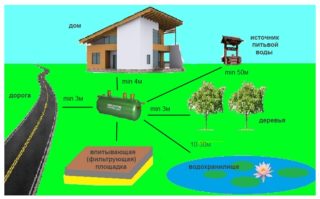A variety of reservoirs are used to collect wastewater from an autonomous sewerage system. These can be septic tanks with wastewater filtration, or sealed containers for the construction of cesspools. They are made from several types of materials, each of which has its own advantages and disadvantages in use. Manufacturers are increasingly offering plastic containers for cesspools. The reason for this demand is in their significant advantages over other types of drives.
Types of storage tanks
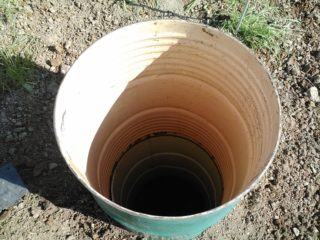
Cesspool tanks are made from different materials. The dimensions depend on the volume of the effluent.
Metal
Metal drums are often used for pit latrine installations. They are durable, containers from various technical fluids can be used.
The main disadvantage of any metal is its susceptibility to corrosion. Rust quickly reduces the strength of the structure. Over time, through damage appears, which leads to leakage of wastewater into the surrounding soil. The tanks are treated with anticorrosive compounds. But it costs more and does not help for long.
The price of ready-made metal tanks is quite high. The use of improvised tanks is often not profitable due to the inability to store sewage drains.
Concrete
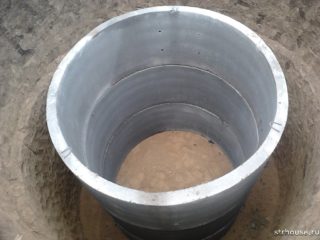
Concrete storage tanks for sewage also do not lose popularity. This design is made:
- Independently, filling the foundation pit with mortar. Such a device will cost less, but it will take a lot of time to manufacture.
- From ready-made concrete rings. They are mounted using special equipment, since the elements are of significant weight. In addition, the structure must be additionally sealed in order to exclude the leakage of wastewater into the soil, or the ingress of moisture from the soil into the tank.
- In the form of a sealed hydro-concrete sump. Such a reservoir has a long service life. It is better to entrust the installation to professionals.
The service life of concrete sedimentation tanks is quite long, but over time, the structure is still destroyed by moisture. Temperature drops are a detrimental factor for concrete. Freeze and thaw cycles lead to gradual corrosion of the container.
Brick
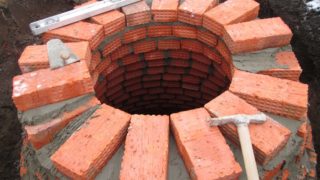
Brick tanks for cesspools are easy enough to make with your own hands. By design, they can be:
- Without a bottom - the simplest version of a well. The main disadvantage of such a container is that the runoff gets into the groundwater.
- From several sections - in this way, a conventional septic tank is obtained, in which the wastewater is divided into fractions and filtered.
- Sealed brick - will provide environmental friendliness on the site.
For the device of brick cesspools, substandard or second-hand material can be used. Such structures have a long service life, they can be made of any shape and size. Brick sedimentation tanks are suitable for various types of soil.
Plastic
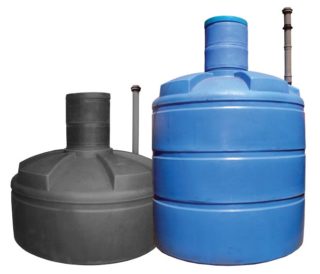
Plastic tanks for cesspools are made:
- made of polypropylene (PP);
- made of low pressure polyethylene (HDPE);
- made of reinforced fiberglass.
In form, they are performed:
- cylindrical;
- rectangular;
- conical.
It is possible to place plastic tanks in the ground horizontally or vertically, depending on the level of groundwater.
Standard plastic container design includes:
- sealed tank with a neck;
- a head soldered to the neck;
- screw cap or hatch;
- a branch pipe for connecting a sewer pipe.
In some models, holes are additionally made for connecting a ventilation pipe, and another head can also be provided. The overflow barrel is equipped with overfilling controls.
Advantages of using plastic containers for cesspools:
- The high strength of the tanks is ensured by the wall thickness, which can reach several centimeters.
- The structures are resistant to temperature extremes.
- They do not lend themselves to the action of aggressive media - the long service life of plastic containers is ensured by the fact that the material does not rot and does not rust.
- The cast tank design and the absence of welded seams exclude drainage leaks.
- The small weight of the container makes it quite easy to transport and install it in the pit.
- Reservoirs of any shape and size are made from plastic. The material is easy to process.
- The price of a plastic container for sewerage is relatively low.
Plastic tanks have a smooth inner surface. Thanks to this, sediments and layers are not formed on the walls.
Structures require reliable fastening in the pit, otherwise, under the influence of groundwater and melt water, the empty tank may shift.
Selection recommendations
- The tank must be equipped with a bottom. This will exclude the ingress of untreated wastewater into the soil and water bodies.
- The depth of the tank location depends on the groundwater level at the site. The bottom edge of the sump should be above the aquifers.
- It is impossible to arrange cesspools closer than 10 m to residential buildings, 20 m - to water bodies.
The size of the sewer tank is selected depending on the amount of wastewater. This mainly depends on the number of people living in the house. It is recommended to take at least 100 liters per family member. If the volume is incorrectly selected, the costs of servicing the sump will increase due to the frequent pumping of wastewater.
The material of construction is chosen based on financial capabilities. Plastic drums are much cheaper than metal, concrete or brick tanks.
Plastic container installation technology
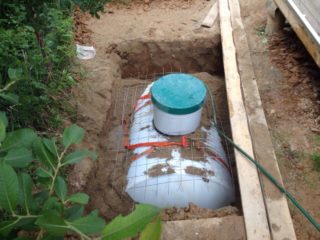
The place of the cesspool device is selected based on sanitary requirements. In this case, it is necessary to provide for the possibility of accessing equipment for pumping out wastewater.
First of all, a pit of the required size is marked and dug out. Installation of plastic containers is carried out on a previously prepared base in a cesspool. It is made of a reinforced concrete pad 15 cm thick, or a compacted sand preparation of 25 cm is used.
A distance of at least 15 cm is left between the walls of the pit and the tank. After the installation of the tank, the voids around are filled with a mixture of sand and cement. For 1 cube of sand, take 50 kg of cement. If the container is threatened with flooding, it is worth increasing the amount of the mixture. You can do with backfilling with ordinary soil.
The price of a tank for cesspools depends on the material, volume, additional devices and accessories. With self-assembly, the total cost of the structure will be much less. However, for a quality device, certain skills are required.

